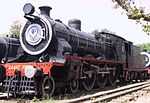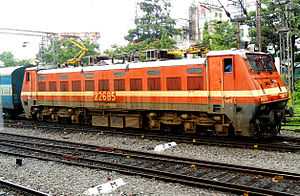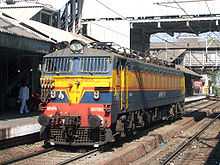USATC S160 Class
| USATC S160 Class China KD6, ÖBB Class 956, ČSD Class 456.1, SNCF Class 140U, SEK Class Θγ (THg), MÁV Class 411, FS Class 736, PKP Tr201 and Tr203, Russia class ШA, Renfe class 553, TCDD 45171 Class, JZ class 37 | |
|---|---|
|
S160 5197 at Cheddleton, Staffordshire. | |
| Type and origin | |
| Power type | Steam |
| Designer | Maj. J. W. Marsh |
| Builder |
American Locomotive Company (755), Baldwin Locomotive Works (712), Lima Locomotive Works (653) |
| Build date | 1942–1946 |
| Total produced | 2120 |
| Specifications | |
| Configuration | 2-8-0 |
| UIC classification | 1′D h2 |
| Gauge | 4 ft 8 1⁄2 in (1,435 mm) standard gauge |
| Leading wheel diameter | 2 ft 9 in (838 mm) |
| Driver diameter | 4 ft 9 in (1,448 mm) |
| Wheelbase | 51 ft 7 3⁄4 in (15.74 m) |
| Length | 61 ft 0 in (18.59 m), including tender |
| Weight on drivers | 140,000 lb (63,503 kg) |
| Locomotive weight | 161,000 lb (73,028 kg) |
| Tender weight | 115,500 lb (52,390 kg) |
| Fuel type | Coal |
| Fuel capacity | 20,000 lb (9,072 kg) |
| Water capacity | 6,500 US gallons (25,000 l; 5,400 imp gal) |
| Boiler | 5 ft 10 in (1.78 m) maximum diameter |
| Boiler pressure | 225 lbf/in2 (1.55 MPa) |
| Firegrate area | 41 sq ft (3.8 m2) |
| Heating surface: – Tubes | 1,055 sq ft (98.0 m2) (150 in or 3,810 mm long × 2 in or 51 mm diameter) |
| – Flues | 567 sq ft (52.7 m2) (30 in or 762 mm long × 5.375 in or 137 mm diameter) |
| – Firebox | 136 sq ft (12.6 m2) |
| – Total | 2,253 sq ft (209.3 m2) |
| Superheater area | 313 sq ft (29.1 m2) |
| Cylinders | Two, outside |
| Cylinder size |
19 in × 26 in (482.6 mm × 660.4 mm) bore x stroke |
| Valve gear | Walschaerts |
| Valve type | 10 inches (254 mm) piston valves |
| Performance figures | |
| Tractive effort | 31,490 lbf (140.1 kN) |
| Career | |
| Class | USATC S160 and country derivatives |
| Official name | USATC S160 Class |
| Locale |
United States European Union China |
The United States Army Transportation Corps S160 Class is a class of 2-8-0 Consolidation steam locomotive designed for use in Europe during World War II for heavy freight work. A total of 2,120 were built and they worked on railroads across the world, including Africa, Asia, all of Europe and South America.
Design
During the 1930s, the United States Army Transportation Corps approved update of a Baldwin Locomotive Works World War I design in contingency for war transportation, to create the S159 Class. During the period of World War Two when America was neutral, the government of Franklin D. Roosevelt approved the Lend-Lease supply to the United Kingdom of the S200 Class, designed specifically to fit into the restricted British loading gauge.[1]
With America's entry to World War Two, the USATC needed a developed design from which to create a volume of locomotive power for the wrecked railways of Europe, which they could use to deploy military hardware and civilian goods. Hence the design created by Maj. J. W. Marsh from the Railway Branch of the Corps of Engineers learnt from both previous locomotives, designed on austerity principles and built using methods which created efficient and fast construction speed over long life,[1] such as axlebox grease lubricators and rolled plates preferred to castings.
With cast frames and cast wheels, the front two driving axles were sprung independently from the rear two driving axles to allow for running on poor quality track. The larger tender layout was derived from the similar design for the WD Austerity 2-8-0, with the coal bunker inset above the water tank to improve visibility when running backwards.
British deployment
800 locomotives were constructed in 1942/3 in thirteen batches, split between ALCO, Baldwin and Lima Locomotive Works. Shipped to South Wales and dispatched from the GWR locomotive depot at Newport, Ebbw Junction, the first 43 locomotives were transferred to the LNER works at Doncaster for completion, and later running in over the East Coast Main Line. This started a pattern whereby each of the four British railway companies eventually deployed a total of 400 S160's under the guise of "running in," but factually replacing damaged stock and increasing the capacity of the British railway system to allow for shipping of military pre-invasion equipment and troops. The eventual deployment of S160's were:
- 174 to the Great Western Railway
- 168 to the London and North Eastern Railway
- 50 to the London, Midland and Scottish Railway
- 6 to the Southern Railway
The second batch of 400 S160's were prepared for storage by USATC personnel at the Great Western's Ebbw Junction locomotive depot in the immediate run-up to D-Day. After the D-Day invasion of Normandy, the locomotives deployed across Britain again began to be collected and be refurbished at Ebbw Junction in preparation for shipment to Europe.
Operational failures
The S160's were designed for quick and efficient building, not long term operations, thus compromises in design led to some difficulties in operations. The axle box grease lubricators were not very efficient, particularly when maintenance procedures lapsed or were delayed for operational war reasons, and so axle boxes often ran hot. Braking was poor for European standards, with a Westinghouse steam brake used for the locomotive,[1] which was woefully insufficient due to the long distance from the driver's valve and the brake cylinder.
The major faults of the S160 were the crown stays in the firebox, coupled with only a single water gauge of an unreliable design, which was prone to blockage, misleading the crew into thinking that the water level was adequate, even though it was becoming dangerously low. The bolts holding the crown stays were found to collapse under heat tension with low water levels and with little warning, resulting in a boiler explosion.[2] In a space of ten months, three UK S160s suffered a collapse of the firebox crown, with the first leading to the death of a GWR fireman on No. 2403 in November 1943.
Deployment
Judging accurately the actual deployment of 2120 locomotives is difficult, but the following numbers are referenced:[2]
Europe
The British locomotives, together with those shipped direct from America were also similarly deployed first with troops reclaiming Europe, and then subsumed throughout European national railways as replacements for their destroyed stock after the war:
- Austria, ÖBB Class 956 – 30 examples, all scrapped[3]
- Czechoslovakia, ČSD Class 456.1 – 80 examples, last of them (456.173) withdrawn in 1972 and scrapped the following year
- France, SNCF Class 140U – 121 examples;
- Germany – 40 examples briefly used in 1947 in American and British zones, based in Bremen. All sold to Hungary in August 1947;
- Greece, SEK Class Θγ (THg) – 27 examples received in 1947 (Θγ 521 to 537 and Θγ 551 to 560), plus 25 examples bought from Italian FS railways in 1959 (Θγ 571 to 595);
- Hungary, MÁV Class 411 – 510 examples, bought at $100,000 each, of which 484 were put into use and allocated service numbers from 411.001 onwards, and 26 cannibalized for spares[4]
- Italy, FS Class 736 – 244 examples, plus four salvaged from a sunken ship, all but eight with oil firing. 25 sold to Greece in 1959, the rest were withdrawn in early 1960s
- Poland, PKP – received 75 S160s from UNRRA and numbered them Tr201-1 – 75; and a further 500 from USATC as Tr203-1 – 500.[4] In PKP service, boiler pressure was reduced to 13 bar (1,300 kPa; 190 psi) and maximum speed was set at 65 km/h (40 mph). Modifications included fitting Trofimov piston valves, electric headlights and cab side doors. One engine was converted to a Tank locomotive in 1957, and designated TKr55[2]
- Soviet Union, Class ШA (ShA) – 200 machines ordered from Baldwin (ШA 1 to 90) and ALCO (ШA 91 to 200), designated S162s and S166s. ШA 52 to 55, 69 and 70 were lost en route to Vladivostok and ШA 13 remained in the USA.[5] In 1957, 50 of them were for 1,067 mm (3 ft 6 in) track and used by the southern Sakhalin Railway[5]
- Spain, Class 553 – in 1958 the Alaska Railroad sold six S160's to the Ferrocarril de Langreo[6][7][8]
- Turkey, TCDD 45171 Class – 50 units, numbered 45171 to 45220[1]
- United Kingdom – none in use with any of the mainline railways after WWII, as most were all exported post D-Day. However one was kept back by the British Army, Alco built works number 71512, and used at their Longmoor Military Railway as their WD 93257 "Carl R Gray Jr".[9] Some have now re-imported for use by preserved railways
- Yugoslavia, JZ – Class 37 - 80 examples
Africa
At the same time as S160s were being deployed into Britain, when General Patton led American troops in Operation Torch into the North African Campaign, their Transport Corps brought with them S160s. These locomotives moved across the north of the continent as Patton's troops waged war, and when the troops moved to Italy the majority of their S160s moved with them. These locomotives, supplemented with those directly imported from America, were eventually to create a group of 243 locomotives, subsumed by the Italian State Railway's to become the FS Class 736 class.
- Algeria, Class 140-U – number unknown
- Morocco, Class 140-B – number unknown
- Tunisia, Class 140-250 – number unknown
Americas

- Mexico, Class GR-28 – 10 examples purchased by FCM directly from Baldwin in 1946 and allocated service numbers 211 to 220, with different pilots and couplers (some sources give 11 examples) – these were the last examples of the S160 to be built
- Peru, Class 80 – 2 examples, probably directly from ALCO in 1943
- United States – an unknown number with USATC and then various military transportation units. Five surplus to requirements of the Alaska Railroad later shipped to Spain
Asia
After World War Two, the reconstruction of the world required transportation. The S160s were deployed to Asia under the United Nations Relief and Rehabilitation Administration, to China and South Korea.[10]
- China, Class KD6 – number unknown. Many were modernized with larger cabs, higher stacks, some fitted with large smoke lifters with horizontal riffles. They were later transferred to industrial operators, mainly coal mines. The last example thought to be KD6 487 withdrawn probably in 1997
- India, class AWC – 60 locomotives were sent to India in kit form for local assembly as 5 ft 6 in (1,676 mm) broad gauge engines. Originally allocated USATC numbers 3433–3492 (Baldwin 70390–70449, 1944) they had their running numbers increased by 3000 by the Indian authorities to avoid numbers in use by the local railway companies.[11] They were split between the East Indian Railway and the South Indian Railway; at the all-India renumbering scheme the former EIR locomotives became 22601–22614, and SIR locomotives became 22615–22660.[11] Forty-five were still in service in June 1977.[11]
- North and South Korea, Class Sori2 – it is not known how many or from where the S160s were deployed to North Korea, but their 2,210 sister decapods were shipped from Portland to Vladivostok under "Lease-Lend" in 1944/5. After the War, these locomotives called "Soyusnitzys" (i.e., from the Russian for "Allies"), were moved to Siberia. They moved to North Korea during the Korean War, carrying 8xxx numbers. Ironically, the S160's were used by both North and South Korean forces during this conflict.[12]
Variants
There were three major variants of the S160 class, excluding inlife design development:
- S161 - designed for deployment in Jamaica on British military railways used by the United States. Later subsumed by the Jamaica Railway Corporation[2]
- S162 and S166 - both designed for Russian broad gauge track
Preservation
Mainly due to their numbers, rather than the design or build quality, at least 25 examples of the S160 have survived into preservation, making them one of the most numerous survivors of all Mainline Steam Locomotives:
| No. | Builder | Post WW2 Owner | Current Owner | Location | Notes |
| 1631 | Alco 70284 | Great Central Railway (Nottingham) | under restoration | ||
| 2138 | Alco 70620 | Great Central Railway (Nottingham) | Source of strategic spares for 1631 | ||
| 2364 | Baldwin 69621 | Great Central Railway (Nottingham) | Chassis only, source for strategic spares for 1631 | ||
| 2627 | Baldwin 69855 | City of Anchorage | |||
| 3523 | Baldwin 70480 | Engine 557 Restoration Company | August,2012, being restored for operation. | ||
| 5846 | Lima 8784 | Crewe Railroad Museum | |||
| 5187 | Lima 8846 | US Army Transportation Museum | |||
| 2628 | Baldwin 69856 | Bill Miller Equipment Sales | Fitted with Franklin Poppet valve gear[13] undergoing restoration | ||
| 2630 | Baldwin 69858 | Southeastern Railway Museum | For Sale / Undergoing restoration | ||
| 1702 | Baldwin 64641 | Great Smoky Mountains Railroad | Undergoing restoration | ||
| 5197 | Lima 8856 | Churnet Valley Railway | Overhaul began 2013 | ||
| 6046 | Baldwin 72080 | Churnet Valley Railway | Overhaul finished July 2012, Returned to service December 2012. Operating on hire at the Nene Valley Railway until 2015. | ||
| 2253 | Baldwin 69496 | North Yorkshire Moors Railway | Cosmetically overhauled. Loaned to National Railway Museum at Shildon until October 2015. | ||
| 5820 | Lima 8758 | Keighley and Worth Valley Railway | Returned to service in January 2014 following overhaul | ||
| 3278 | Baldwin 70340 | Tyseley Locomotive Works | #701 Franklin D. Roosevelt, Under overhaul at Tyseley for Long Marston Military Railway | ||
| 5164 | Lima 8823 | Polskie Koleje Państwowe | |||
| 2438 | ALCO 70787 | Polskie Koleje Państwowe | |||
| 5801 | Lima 8739 | Polskie Koleje Państwowe | |||
| 3540 | Alco 70587 | Hungarian Railway Museum | Operational | ||
| 2781 | Lima 8434 | Railway station | Plinthed | ||
| 6056 | Baldwin 72090 | Railway station | Plinthed | ||
| 2206 | Lima 8212 | OSE | stored | ||
| 2524 | Lima 8341 | Turkish State Railways | |||
| 2879 | Alco 71076 | Turkish State Railways | |||
| 3324 | Alco 71579 | FS | |||
| — | Baldwin-Lima-Hamilton 75503 | Tennessee Valley Railroad Museum | Out of service for her 1472 inspection & rebuild. 610 is technically not an S-160 but classified as a type A, constructed in 1952 | ||
See also
- The Museum of the Moscow Railway, at Paveletsky Rail Terminal, Moscow
- Rizhsky Rail Terminal, Home of the Moscow Railway Museum
- Varshavsky Rail Terminal, St.Petersburg, Home of the Central Museum of Railway Transport, Russian Federation
- History of rail transport in Russia
References
- ↑ 1.0 1.1 1.2 1.3 45171 to 45220 trainsofturkey.com
- ↑ 2.0 2.1 2.2 2.3 Tr201/Tr203 locomotives.com.pl
- ↑ http://www.30937.co.uk/AUST_CLASS_STEA_OBB.htm
- ↑ 4.0 4.1 USATC S160 2-8-0 No. 5197 & 6046 The Churnet Valley Guide
- ↑ 5.0 5.1 Rakov 1995, pp. 338–339
- ↑ Tourret 1977, pp. 63–64
- ↑ USATC Steam Locomotives 1942 - 1947
- ↑ http://www.ratrust.org/Photos/Spain/Locomotives/Narrow_Gauge__W_/N_G__West/n_g__west_23.html
- ↑ http://www.railalbum.co.uk/steam-locomotives/usatc-s160-1.htm
- ↑ Vintage Shenyang Area Pictures January 1985
- ↑ 11.0 11.1 11.2 Hughes 1979, pp. 35–36
- ↑ A Glimpse of North Korea's Railways Florian Schmidt for Continental Railway Journal
- ↑ Saul Nadler's Photos
- Hughes, Hugh (1977). Steam Locomotives in India, Part 3 – Broad Gauge. Harrow, Middlesex: The Continental Railway Circle. ISBN 0-9503469-4-2.
- Rakov, V. A. (1995). Lokomotivy otechestvennykh zheleznykh dorog 1845–1955 (in Russian). Moscow. ISBN 5-277-00821-7.
- Tourret, R. (1977). United States Army Transportation Corps Locomotives. Abingdon: Tourret Publishing. ISBN 0-905878-01-9.
External links
| Wikimedia Commons has media related to USATC S160 Class. |
- "The USATC S160 2-8-0s". www.lner.info. The London & North Eastern Railway (LNER) Encyclopedia.
- "The USATC steam locomotives in Greece, 1947, 1959". www.gregoriou.itgo.com (in Greek).
- "45171 to 45220". www.trainsofturkey.com.
| ||||||||||||||||||||||||||||||||||||||||||||||||||||||||||||||||||||||||||||||||||||||||||||||||||||||||||||||||||||||||||||||||||||||||||||||||||||||||||||||||||||||||||||||||||||||||||||||||||||||||||||||||||||||||||||||||||||||||||||||||||||||||||||||||||||||||||||||||||||||||||||||||||||||||||||||||||||||||||||||||




